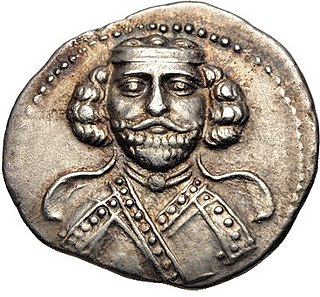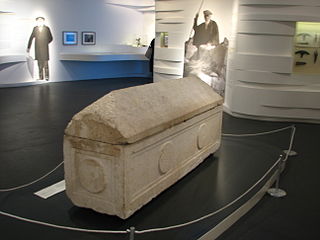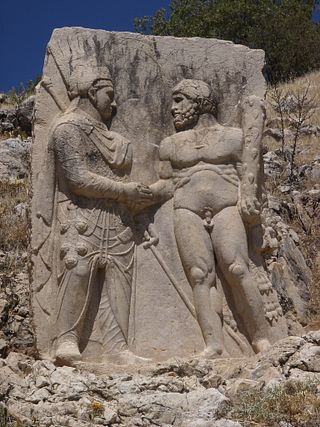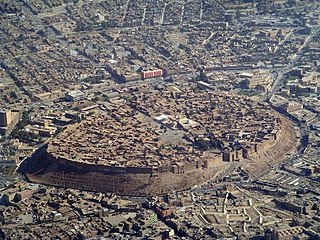
Adiabene was an ancient kingdom in northern Mesopotamia, corresponding to the northwestern part of ancient Assyria. The size of the kingdom varied over time; initially encompassing an area between the Zab Rivers, it eventually gained control of Nineveh and starting at least with the rule of Monobazos I, Gordyene became an Adiabenian dependency. It reached its zenith under Izates II, who was granted the district of Nisibis by the Parthian king Artabanus II as a reward for helping him regain his throne. Adiabene's eastern borders stopped at the Zagros Mountains, adjacent to the region of Media. Arbela served as the capital of Adiabene.

Phraates III, was King of Kings of the Parthian Empire from 69 BC to 57 BC. He was the son and successor of Sinatruces.

Assyria was a short-lived Roman province in Mesopotamia that was created by Trajan in 116 during his campaign against the Parthian Empire. After Trajan's death, the newly proclaimed emperor Hadrian ordered the evacuation of Assyria in 118.

Abdissares was the first king of Adiabene, ruling sometime in the first half of the 2nd-century BC. Scholarship initially considered him to be the ruler of Sophene, due to stylistic similarities between his coins and the ones in Commagene and Sophene. However, this has now been debunked. It has now been established that Abdissares' name—contrary to the Sophenian kings—was not of Iranian origin, but of Semitic, meaning "servant of Ishtar," a name primarily used by Semitic inhabitants. The goddess Ishtar enjoyed great popularity in the heartland of ancient Assyria, where Adiabene was located.
Ishoʿyahb III of Adiabene was Patriarch of the Church of the East from 649 to 659.

Helena of Adiabene was a queen mother of Adiabene, a vassal state of the Parthian Empire. With her husband-brother Monobaz I, she was the mother of Izates II and Monobaz II. Helena became a convert to Judaism about the year 30 CE. According to Josephus, Helena was the daughter of King Izates. Moses of Chorene makes her the chief wife of Abgar V, king of Edessa.
Monobaz I was king of the Parthian client state of Adiabene in the 20s and 30s of the 1st century AD. He was the husband of Queen Helena of Adiabene. With Helena he fathered Izates bar Monobaz and Monobaz II. Midrash Genesis Rabbah 46:10 conflates the identity of Monobaz I with King Ptolemy, “‘And circumcise the flesh of your foreskin’ : [The foreskin] hangs on the body like a sore (nomi). It happened that king Munbaz and Zawatus (=Izates), the sons of King Ptolemy, were sitting and reading the book of Genesis. When they came to this verse, ‘and circumcise the flesh of your foreskin,’ one turned his face to the wall and began to cry, and the other turned his face to the wall and [also] began to cry.[21] Then each of them went and had himself circumcised [without the other knowing].”
Monobazus II was the son of Queen Helena of Adiabene and King Monobazus I. He is known as Monobaz in the Babylonian Talmud.

Izates II was king of the Parthian client kingdom of Adiabene from approximately 30 to 54. He is notable for converting to Judaism. He was the son of Queen Helena of Adiabene and Monobaz I of Adiabene. Queen Helena was also said to be the wife of King Abgarus of Edessa and thus the queen of Edessa too.
Meharaspes, also written as Mebarsapes or Mehrasp, was the Parthian client king of Adiabene in the early 2nd century CE; he was also the last king of an independent Adiabene. He was defeated by Trajan in 116; Adiabene was incorporated into the short-lived Roman province of Mesopotamia.
Sames or Samos II Theosebes Dikaios was the second king of Commagene. He was the son and successor of Ptolemaeus of Commagene.

Mithridates I Callinicus was a king of Orontid Iranian descent who lived during the late 2nd century BC and early 1st century BC. Mithridates was a prince, the son, and successor of King of Commagene, Sames II Theosebes Dikaios. Before his succession in 109 BC, he married the Syrian Greek Princess Laodice VII Thea, daughter of King Antiochus VIII Grypus and Ptolemaic princess Tryphaena, as a part of a peace alliance. Mithridates embraced Greek culture. Laodice bore Mithridates a son, Antiochus I Theos of Commagene, a prince and future king of Commagene. Mithridates died in 70 BC and Antiochus succeeded him.
Timothy I was the Patriarch of the Church of the East from 780 to 823 and one of its most influential patriarchs. He was also an author, church leader, diplomat, and administrator. During his reign he reformed the metropolitan administration of the Church of the East, granting greater independence to the metropolitan bishops of the mission field but excluding them from participation in patriarchal elections. These reforms laid the foundations for the later success of Church of the East missions in Central Asia.

Metropolitanate of Adiabene was an East Syriac metropolitan province of the Church of the East between the 5th and 14th centuries, with more than fifteen known suffragan dioceses at different periods in its history. Although the name Hadyab normally connoted the region around Erbil and Mosul in present-day Iraq, the boundaries of the East Syriac metropolitan province went well beyond the Erbil and Mosul districts. Its known suffragan dioceses included Beth Bgash and Adarbaigan, well to the east of Adiabene proper.

Erbil, also called Hawler, is the capital and most populated city in the Kurdistan Region of Iraq. The city is in the Erbil Governorate.
The Diocese of Salakh was an East Syriac diocese of the Church of the East in the metropolitan province of Adiabene, attested in the eighth and ninth centuries.
Orontes III was King of Armenia. In his reign he struggled for control of the Kingdom of Sophene with king Antiochus II Theos until being defeated in 272 BC and was forced to pay a large tribute which included 300 talents of silver and 1,000 horses and mules. Orontes III was subsequently murdered in 260 BC, whether at the instigation of King Antiochus II is not recorded. His son, Sames, continued to rule in Sophene.

Orontes IV was the son of King Arsames and is recorded as ruling Armenia from inscriptions found at the historic capital of the Orontid dynasty, Armavir. He was the founder of the city of Yervandashat and Ervandakert. In his reign the religious site of Bagaran was founded. Large bronze statues in the Hellenistic style of the gods, Zeus (Aramazd), Artemis (Anahit) and Herakles (Vahagn) were brought there and set up in temples dedicated to them. He is also said to have founded a shrine at Armavir dedicated to Apollo (Mithra), a golden statue of four horses pulling a chariot with Apollo as god of the Sun. This was later destroyed by the Sassanid Persian army in the 4th century AD.
Michał Marciak is Associate Professor of History at Jagiellonian University since 2018, specializing in Jewish studies. He has a MA in history (2007), a MA in theology (2007), and received his PhD in 2012 from the Faculty of Humanities of the University of Leiden.








